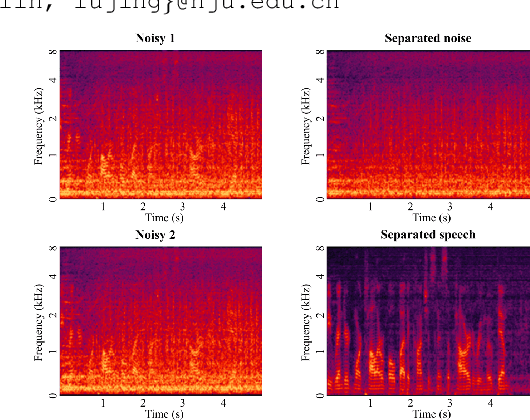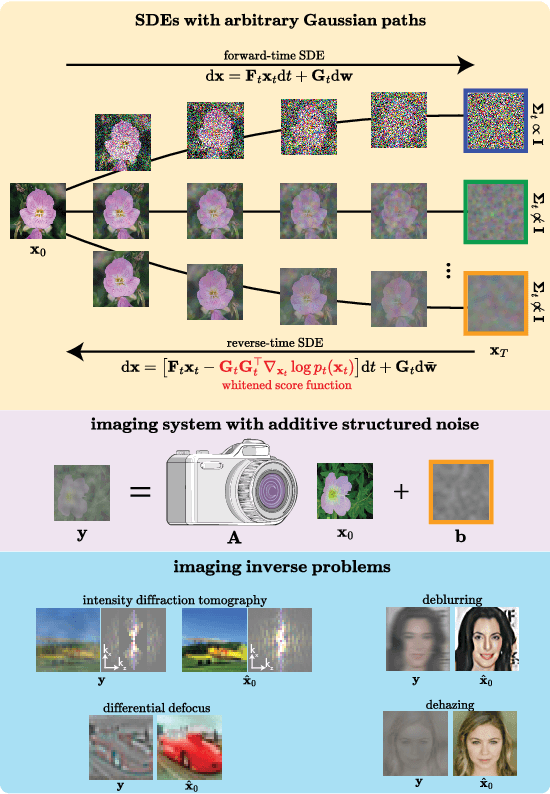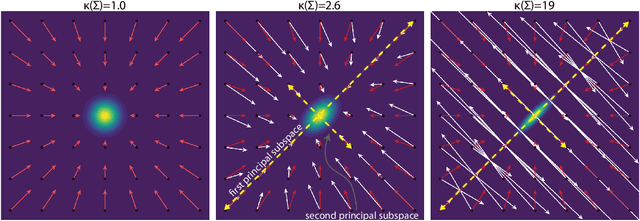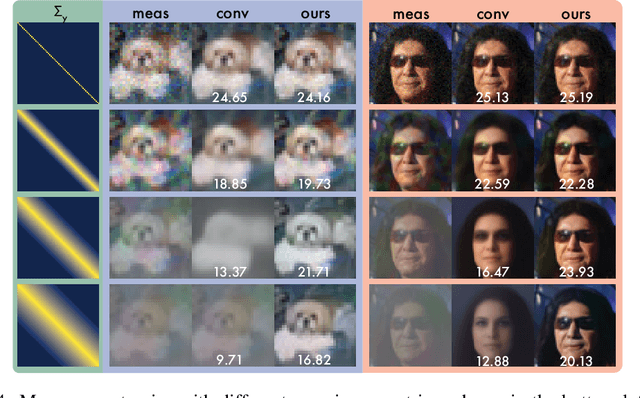Yu Sun
Sherman
PRISM: Probabilistic and Robust Inverse Solver with Measurement-Conditioned Diffusion Prior for Blind Inverse Problems
Sep 19, 2025Abstract:Diffusion models are now commonly used to solve inverse problems in computational imaging. However, most diffusion-based inverse solvers require complete knowledge of the forward operator to be used. In this work, we introduce a novel probabilistic and robust inverse solver with measurement-conditioned diffusion prior (PRISM) to effectively address blind inverse problems. PRISM offers a technical advancement over current methods by incorporating a powerful measurement-conditioned diffusion model into a theoretically principled posterior sampling scheme. Experiments on blind image deblurring validate the effectiveness of the proposed method, demonstrating the superior performance of PRISM over state-of-the-art baselines in both image and blur kernel recovery.
Dataset and Benchmark for Enhancing Critical Retained Foreign Object Detection
Jul 09, 2025Abstract:Critical retained foreign objects (RFOs), including surgical instruments like sponges and needles, pose serious patient safety risks and carry significant financial and legal implications for healthcare institutions. Detecting critical RFOs using artificial intelligence remains challenging due to their rarity and the limited availability of chest X-ray datasets that specifically feature critical RFOs cases. Existing datasets only contain non-critical RFOs, like necklace or zipper, further limiting their utility for developing clinically impactful detection algorithms. To address these limitations, we introduce "Hopkins RFOs Bench", the first and largest dataset of its kind, containing 144 chest X-ray images of critical RFO cases collected over 18 years from the Johns Hopkins Health System. Using this dataset, we benchmark several state-of-the-art object detection models, highlighting the need for enhanced detection methodologies for critical RFO cases. Recognizing data scarcity challenges, we further explore image synthetic methods to bridge this gap. We evaluate two advanced synthetic image methods, DeepDRR-RFO, a physics-based method, and RoentGen-RFO, a diffusion-based method, for creating realistic radiographs featuring critical RFOs. Our comprehensive analysis identifies the strengths and limitations of each synthetic method, providing insights into effectively utilizing synthetic data to enhance model training. The Hopkins RFOs Bench and our findings significantly advance the development of reliable, generalizable AI-driven solutions for detecting critical RFOs in clinical chest X-rays.
ReasonMed: A 370K Multi-Agent Generated Dataset for Advancing Medical Reasoning
Jun 11, 2025Abstract:Though reasoning-based large language models (LLMs) have excelled in mathematics and programming, their capabilities in knowledge-intensive medical question answering remain underexplored. To address this, we introduce ReasonMed, the largest medical reasoning dataset, comprising 370k high-quality examples distilled from 1.7 million initial reasoning paths generated by various LLMs. ReasonMed is constructed through a \textit{multi-agent verification and refinement process}, where we design an \textit{Error Refiner} to enhance the reasoning paths by identifying and correcting error-prone steps flagged by a verifier. Leveraging ReasonMed, we systematically investigate best practices for training medical reasoning models and find that combining detailed Chain-of-Thought (CoT) reasoning with concise answer summaries yields the most effective fine-tuning strategy. Based on this strategy, we train ReasonMed-7B, which sets a new benchmark for sub-10B models, outperforming the prior best by 4.17\% and even exceeding LLaMA3.1-70B on PubMedQA by 4.60\%.
Lingshu: A Generalist Foundation Model for Unified Multimodal Medical Understanding and Reasoning
Jun 08, 2025Abstract:Multimodal Large Language Models (MLLMs) have demonstrated impressive capabilities in understanding common visual elements, largely due to their large-scale datasets and advanced training strategies. However, their effectiveness in medical applications remains limited due to the inherent discrepancies between data and tasks in medical scenarios and those in the general domain. Concretely, existing medical MLLMs face the following critical limitations: (1) limited coverage of medical knowledge beyond imaging, (2) heightened susceptibility to hallucinations due to suboptimal data curation processes, (3) lack of reasoning capabilities tailored for complex medical scenarios. To address these challenges, we first propose a comprehensive data curation procedure that (1) efficiently acquires rich medical knowledge data not only from medical imaging but also from extensive medical texts and general-domain data; and (2) synthesizes accurate medical captions, visual question answering (VQA), and reasoning samples. As a result, we build a multimodal dataset enriched with extensive medical knowledge. Building on the curated data, we introduce our medical-specialized MLLM: Lingshu. Lingshu undergoes multi-stage training to embed medical expertise and enhance its task-solving capabilities progressively. Besides, we preliminarily explore the potential of applying reinforcement learning with verifiable rewards paradigm to enhance Lingshu's medical reasoning ability. Additionally, we develop MedEvalKit, a unified evaluation framework that consolidates leading multimodal and textual medical benchmarks for standardized, fair, and efficient model assessment. We evaluate the performance of Lingshu on three fundamental medical tasks, multimodal QA, text-based QA, and medical report generation. The results show that Lingshu consistently outperforms the existing open-source multimodal models on most tasks ...
Advantageous Parameter Expansion Training Makes Better Large Language Models
May 30, 2025



Abstract:Although scaling up the number of trainable parameters in both pre-training and fine-tuning can effectively improve the performance of large language models, it also leads to increased computational overhead. When delving into the parameter difference, we find that a subset of parameters, termed advantageous parameters, plays a crucial role in determining model performance. Further analysis reveals that stronger models tend to possess more such parameters. In this paper, we propose Advantageous Parameter EXpansion Training (APEX), a method that progressively expands advantageous parameters into the space of disadvantageous ones, thereby increasing their proportion and enhancing training effectiveness. Further theoretical analysis from the perspective of matrix effective rank explains the performance gains of APEX. Extensive experiments on both instruction tuning and continued pre-training demonstrate that, in instruction tuning, APEX outperforms full-parameter tuning while using only 52% of the trainable parameters. In continued pre-training, APEX achieves the same perplexity level as conventional training with just 33% of the training data, and yields significant improvements on downstream tasks.
A Lightweight Hybrid Dual Channel Speech Enhancement System under Low-SNR Conditions
May 26, 2025



Abstract:Although deep learning based multi-channel speech enhancement has achieved significant advancements, its practical deployment is often limited by constrained computational resources, particularly in low signal-to-noise ratio (SNR) conditions. In this paper, we propose a lightweight hybrid dual-channel speech enhancement system that combines independent vector analysis (IVA) with a modified version of the dual-channel grouped temporal convolutional recurrent network (GTCRN). IVA functions as a coarse estimator, providing auxiliary information for both speech and noise, while the modified GTCRN further refines the speech quality. We investigate several modifications to ensure the comprehensive utilization of both original and auxiliary information. Experimental results demonstrate the effectiveness of the proposed system, achieving enhanced speech with minimal parameters and low computational complexity.
Neural Inverse Scattering with Score-based Regularization
May 20, 2025Abstract:Inverse scattering is a fundamental challenge in many imaging applications, ranging from microscopy to remote sensing. Solving this problem often requires jointly estimating two unknowns -- the image and the scattering field inside the object -- necessitating effective image prior to regularize the inference. In this paper, we propose a regularized neural field (NF) approach which integrates the denoising score function used in score-based generative models. The neural field formulation offers convenient flexibility to performing joint estimation, while the denoising score function imposes the rich structural prior of images. Our results on three high-contrast simulated objects show that the proposed approach yields a better imaging quality compared to the state-of-the-art NF approach, where regularization is based on total variation.
Super-Resolution Optical Coherence Tomography Using Diffusion Model-Based Plug-and-Play Priors
May 20, 2025Abstract:We propose an OCT super-resolution framework based on a plug-and-play diffusion model (PnP-DM) to reconstruct high-quality images from sparse measurements (OCT B-mode corneal images). Our method formulates reconstruction as an inverse problem, combining a diffusion prior with Markov chain Monte Carlo sampling for efficient posterior inference. We collect high-speed under-sampled B-mode corneal images and apply a deep learning-based up-sampling pipeline to build realistic training pairs. Evaluations on in vivo and ex vivo fish-eye corneal models show that PnP-DM outperforms conventional 2D-UNet baselines, producing sharper structures and better noise suppression. This approach advances high-fidelity OCT imaging in high-speed acquisition for clinical applications.
Whitened Score Diffusion: A Structured Prior for Imaging Inverse Problems
May 15, 2025



Abstract:Conventional score-based diffusion models (DMs) may struggle with anisotropic Gaussian diffusion processes due to the required inversion of covariance matrices in the denoising score matching training objective \cite{vincent_connection_2011}. We propose Whitened Score (WS) diffusion models, a novel SDE-based framework that learns the Whitened Score function instead of the standard score. This approach circumvents covariance inversion, extending score-based DMs by enabling stable training of DMs on arbitrary Gaussian forward noising processes. WS DMs establish equivalence with FM for arbitrary Gaussian noise, allow for tailored spectral inductive biases, and provide strong Bayesian priors for imaging inverse problems with structured noise. We experiment with a variety of computational imaging tasks using the CIFAR and CelebA ($64\times64$) datasets and demonstrate that WS diffusion priors trained on anisotropic Gaussian noising processes consistently outperform conventional diffusion priors based on isotropic Gaussian noise.
Ultrasound Report Generation with Multimodal Large Language Models for Standardized Texts
May 13, 2025Abstract:Ultrasound (US) report generation is a challenging task due to the variability of US images, operator dependence, and the need for standardized text. Unlike X-ray and CT, US imaging lacks consistent datasets, making automation difficult. In this study, we propose a unified framework for multi-organ and multilingual US report generation, integrating fragment-based multilingual training and leveraging the standardized nature of US reports. By aligning modular text fragments with diverse imaging data and curating a bilingual English-Chinese dataset, the method achieves consistent and clinically accurate text generation across organ sites and languages. Fine-tuning with selective unfreezing of the vision transformer (ViT) further improves text-image alignment. Compared to the previous state-of-the-art KMVE method, our approach achieves relative gains of about 2\% in BLEU scores, approximately 3\% in ROUGE-L, and about 15\% in CIDEr, while significantly reducing errors such as missing or incorrect content. By unifying multi-organ and multi-language report generation into a single, scalable framework, this work demonstrates strong potential for real-world clinical workflows.
 Add to Chrome
Add to Chrome Add to Firefox
Add to Firefox Add to Edge
Add to Edge